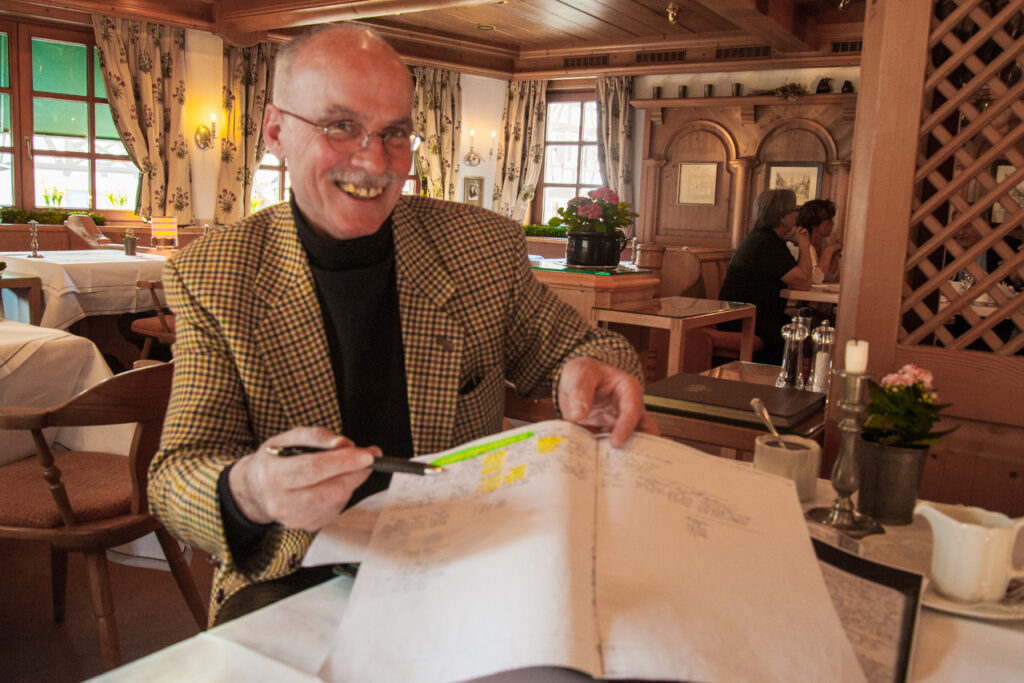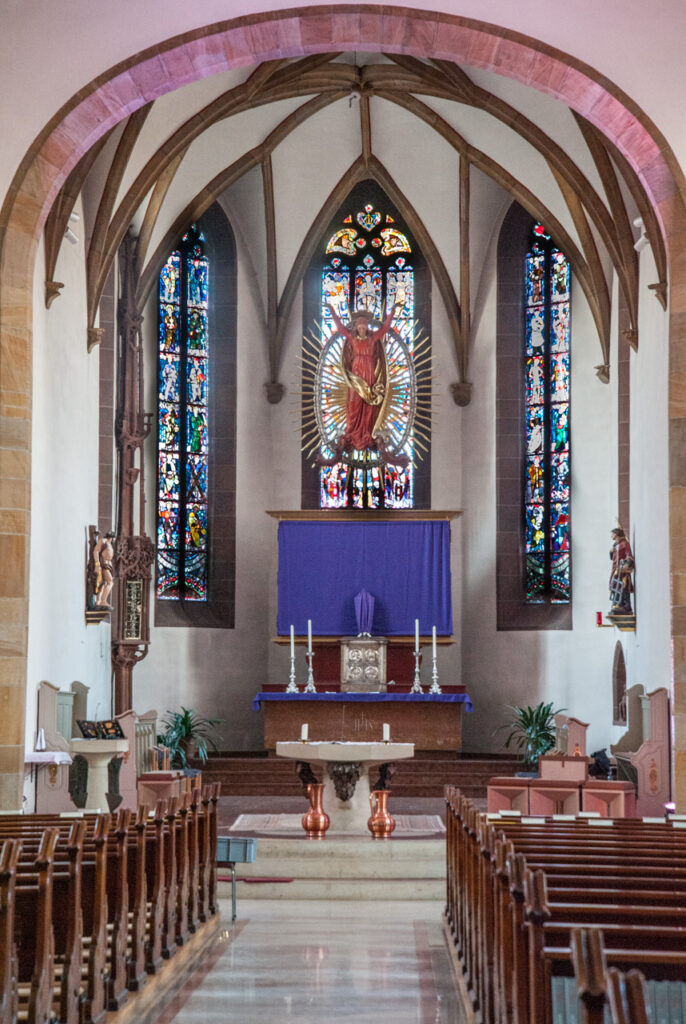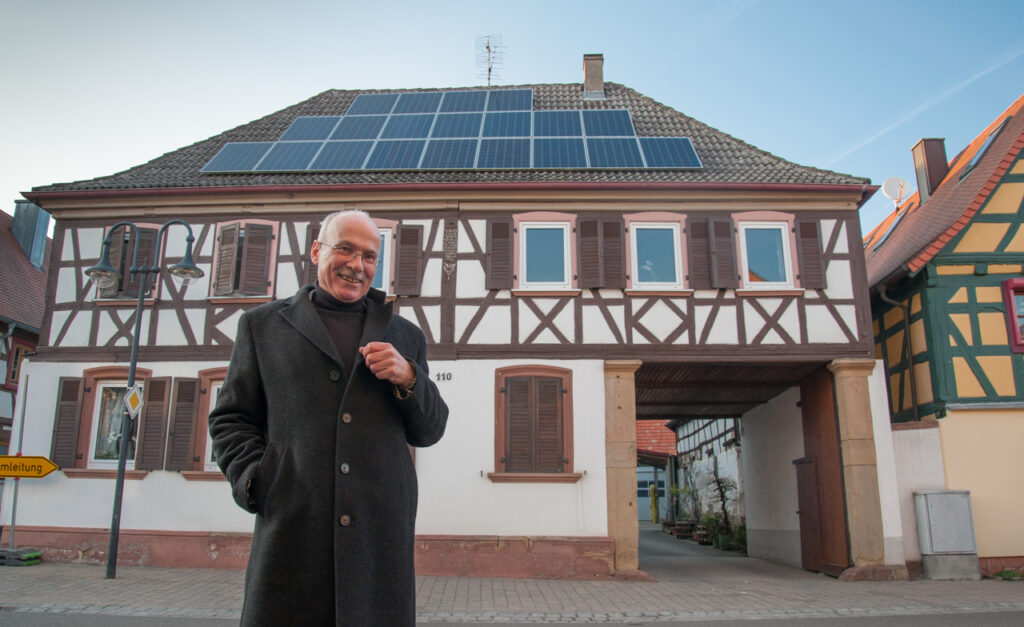I had visited Germany on numerous occasions prior to living here. And every time I visited I felt an odd sense of belonging. As long as I didn’t open my mouth to speak, I even felt German. I felt comfortable and at home. And in a way, I was indeed home. Half of me is German. My father is half German and my mother is half German.
For 15 years, I have been trying to piece together the jigsaw puzzle that constitutes how I came to be. While researching my father’s ancestry, I kept being drawn to a tiny village in wine region of southwestern Germany … Herxheim. ‘This is where it all begins,’ I would think. After years of research I managed to extend my family tree in Herxheim to the mid-1600s. But Herxheim for me was just a dot on a map and all of these listings in my family tree were just faceless names.
In one of life’s twists of fate, I moved to another village in the same German state as Herxheim – a mere two hours north. So last weekend, Padma and I travelled to Herxheim and I set out on a mission to find out where my family came from and to touch the ground my ancestors had tread on and possibly even find distant cousins.
But two days prior to departure I knew no one in Herxheim and didn’t have a clue how I was going to just drop in and find distant family. I wasn’t expecting to find anyone but figured Padma and I would just roam the streets of my ancestral home and have a nice meal or two.
I had been searching the Internet for ‘Adam’ and ‘Herxheim’ and sending messages to anyone I could. No one responded. But two days before we left, my Facebook Messenger dinged with a message ‘please send me your email address’. I did and two hours later, I received an email outlining five generations of my ancestors in Herxheim. BINGO. I hit paydirt and could barely sleep the next two nights in excited anticipation.

THE MASTER BUTCHER
‘He is the most famous Master Adam in Herxheim,’ the email said. He had appeared in documentaries including one by National Geographic. I was so excited. My cold calls came through for a second time and I received another email from a distant cousin with phone numbers of people of the Adam surname in the village.
I sent a text message to the butcher, Walter Adam Jr, and explained my quest. Within 10 minutes I got a call from a man rambling on in German. After listening for a while I explained I didn’t understand a word he said. Fortunately, Walter spoke some English and we agreed to meet at his butcher shop the next day.
When Padma and I arrived at the butcher’s shop, Walter had just finished a long morning of slaughtering, curing and making sausages. After he greeted us the first thing Walter wanted to show us was his hog. But the butcher didn’t show us a pig. He pointed to an immaculate Harley Davidson, which was just itching for the arrival of spring. I was quick to point out that like the Harley, I came from Wisconsin.
We had literally just walked off the street, but the award-winning butcher had time to give us a full tour of his pride and joy. He showed us where he calms the animals the day before the slaughter, where he cures the meat, where he makes sausages and where he stores his condiments. I asked him who holds the recipes for his award-winning sausages and he pointed to his head. ‘Only in here’, he said. ‘No one else knows.’ Despite my pleas of being family he wouldn’t share his recipes with me.
Walter brought us upstairs from his butcher shop to his home and shared with us a photobook about the 10-year anniversary of his business. I tried to determine if we were in fact related but we weren’t getting far. He called his father who arrived 10 minutes later with a book showing the family’s Adam line of ancestry. Walter paged through the book and called out his grandfathers and I checked my list. No match. No match. No match. I started to think we really weren’t related at all and I was wasting his time. Then he turned the page to Joannes George Adam. BINGO. I had Joannes George, born in 1770, in my tree. We were fifth cousins. We high fived each other happy to find a link and it didn’t matter how far back it was.
Padma and I left the butcher’s home happy that we had made a new family friend and promised Walter we would return in summer and take up his offer for a ride on his hog.

MY GREAT GREAT GRANDFATHER ISN’T MY GREAT GREAT GRANDFATHER
‘Your great great grandfather died in 1866,’ the man sitting across from me in the restaurant said.
‘No. No. That’s wrong,’ I said. ‘My great great grandfather died in 1889.’ I reached for a printout of a news item from the Cincinnati Evening Post in 1889. ‘Hanged in a Brewery … horrible death of Mathias Adam, a Banner Employee,’ I read the headline.
‘Your great great grandfather died here … here in Herxheim,’ he said and pointed to the ground. ‘Here in Germany’. I looked at him with a perplexed look. I prided myself in the accuracy of my genealogical research. Did I get it all wrong, I thought?
Two days before Padma and I travelled to Herxheim, my cold calls finally paid off. Of all the emails and Facebook messages I sent I got a hit. Wolfgang Adam of Herxheim replied to my email with a list of five generations of my Adam ancestors. BINGO. The next day he sent me two photos of books and papers. ‘I’m at the Herxheim Archives looking for your family. Bis morgen. See you tomorrow.’
Wolfgang came to our hotel the following day with a folder of papers under his arm. He was as excited to meet me as I was of him. The 60-year-old postal letter carrier had lived in Herxheim his entire life and had a wife and three sons all in the area.
He rolled out the results of his research on the restaurant table and pointed at the name Mathias Adam. ‘This Mathias Adam married your great grandfather and immigrated to America,’ he said. ‘But he is not your great great grandfather. THIS is your great great grandfather,’ Wolfgand said and shifted his pen to another ancestry line. ‘He died a few years after your great grandfather was born. Your great great grandmother remarried … to another man, also named Mathias Adam.’
Wolfgang then showed me his ancestral line and we found our common ancestor. Again I was so happy that I was actually related to this man who Padma and I grew so fond of. Wolfgang packed up his charts and then took us on a tour of Herxheim. Two days earlier, he had never heard of us, but now he gave up his Saturday afternoon to share his community with a new found cousin.
THE PLAGUE – Laurentius Brotweihe
I can only trace my ancestors in Herxheim to the mid-17th century. On my visit I discovered why. In 1666 there was a plague in Herxheim and somehow records before that were lost. During the plague, Herxheim was quarantined, and no one was allowed in or out. To prevent the inhabitants from starving, neighboring villagers left food on the outskirts of town. The people of Herxheim made a vow to God, that if He spared them from death, every year after the harvest, they would donate a wagonload of bread to the neighboring villagers who were giving them food. So, every year since 1667, Herxheim has maintained this tradition known as the Laurentius Brotweihe, or St. Lawrence Bread Dedication. It takes place every year on the Sunday after August 10, which is the feast of St. Lawrence.

St. Maria Himmelfahrt
It was quite overwhelming to stand at the altar where my great grandfather had been christened and where a long line of my ancestors had been married. The St Maria Himmelfahrt Catholic Church has been the central meeting point in Herxheim since, who knows when. It was mentioned in 13th century documents but probably a church existing on the present site well before that. The choir (shown in this photo) was built in 1507 and the existing belfry was built in 1585. For my Herxheim ancestors, who were Catholics, life centred around this church.

THE FAMILY HOME
Wolfgang brought us on a tour of Hexheim and showed us our ancestral home. Our sixth great grandfather, Johann Adam, built this house in 1728.
The family home was built in 1728 and still stands.
Im Na
men des Hern
hat Geba
ut Johan
nes adam und seine ehfrau ma
Gdalena adam in
1728
In the name of the Lord has built Johannes Adam and his wife Magdalena Adam in 1728
FIFTH COUSINS
Walter Adam Jun and his new found cousin.
The belfry of St. Maria Himmelfahrt
St. Maria Himmelfahrt – the church of my ancestors.
The oldest house still standing in Herxheim. It was built in the mid 16th century.
My family left Herxheim in 1880 just as the tobacco industry was taking out. Tobacco would drive the economy for nearly a century. Agriculture remains the main economic force of the region but wine has now replaced tobacco as the main cash crop.
THE POOR HOUSE
In 1847, a soup kitchen for the poor of the village was developed in the estate of a former noble family. Up to 700 people were provided with a warm meal every day by Niederbronn sisters and women from Herxheim. It is now a senior citizen’s center.
Half timbered home line main street Herxheim.

